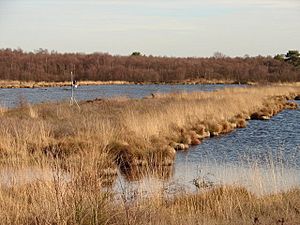Hatfield Moors facts for kids
| Site of Special Scientific Interest | |
 |
|
| Area of Search | South Yorkshire |
|---|---|
| Interest | Biological |
| Area | 1400.7 hectares |
| Notification | 1954 |
| Location map | Nature on the map |
Hatfield Moors is a very special natural area in South Yorkshire, England. It covers a huge space, about 1,400 hectares (that's like 3,460 football fields!). This area is so important for nature that it was officially named a Site of Special Scientific Interest (SSSI) in 1954. This means it's protected because of its unique plants, animals, and habitats. Natural England helps to look after this amazing place. People have known about the rich wildlife here for hundreds of years.
Contents
What is Hatfield Moors?
Hatfield Moors is what's left of a much larger raised bog in the Humberhead Levels. A raised bog is a special type of wetland that gets all its water from rain, not from rivers or groundwater. This makes its soil very acidic and low in nutrients. Hatfield Moors is the second largest lowland raised peat bog in all of England!
The Peat Bog's History
For many years, people cut and removed a lot of peat from this area. Peat is made from dead plants that don't fully decay because of the wet, acidic conditions. It can be used as fuel or in gardening. Luckily, peat-cutting has now stopped at Hatfield Moors. This allows the bog to heal and grow back naturally.
Lindholme Island and Ancient Discoveries
Underneath the peat, there are layers of sand and gravel. In one spot, these layers rise to the surface, forming a small dry area called Lindholme Island.
In 2004, something amazing was found here: an ancient wooden trackway! This trackway was built during the late Neolithic period, which was about 4,500 to 2,500 BC. It was about 45 meters (148 feet) long and had rails about 2 meters (6.5 feet) apart. The trackway stretched from dry land across a shallow pool to a wooden platform. The people who built it used poles from Scots pine trees, showing what kind of trees grew in the area back then.
Plants and Animals of Hatfield Moors
Hatfield Moors is home to many different kinds of plants and animals, some of which are quite rare.
Unique Plants
In the drier parts of the bog, you can find small shrubs like heather and cross-leaved heath. These plants are tough and can handle the bog's conditions.
In the wetter areas, you'll see plants like:
- Common cottongrass
- Hare's-tail cottongrass
- Bog cranberry
- Bog-rosemary
- Bog-myrtle
You'll also find several types of Sphagnum moss. This moss is super important for bogs because it can hold a lot of water and helps create the peat.
Interesting Insects
The bog is a great place for many insects. Some rare ones include:
- The mire pill beetle
- Other uncommon types of beetles
- The bog rush cricket
- The large heath butterfly
Birds and Water Life
Many birds choose Hatfield Moors as their home. You might spot various small birds that live on heathland. Other special birds that breed here include:
- The nightingale (known for its beautiful song)
- Nightjars (which are active at night)
- Three different kinds of owls
The water in the drainage ditches around the bog is also full of life. These ditches provide a home for:

